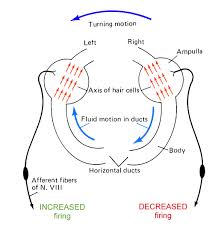The detection of sudden movements (accelerations) to the head is performed by the three Semi-Circular Canals. This information is sent to the brainstem, to and induces sudden changes in posture that compensate for the acceleration.
The diagram opposite shows that when the head is rotated in one direction the semicirular canals on both sides experience movement of the endolymph in the opposite derection. One set of hair cells bends so as to increase the dischearge in the vestibular nerve on that side. But on the opposite side, the tonic discharge arising from that ampulla is inhibited. |
 * *
|
Nystagmus - 'Dancing Eyes'- is an involuntary eye movement consisting of a rapid movement of the eyes in one direction, followed by a slow movement back to the starting position.
Physiological Nystagmus
When the head is rotated, distant visual images would move beyond the visual field very rapidly, and reflexes initiated by the semicircular canals attempt to fixate the gaze on the moving object. This involves a slow movement of the eyes in the direction opposite to the rotation, during which the retina fixates and follows the distant object, followed by a rapid movement of the eyes in the direction of rotation after whch the eye fixates on a new distant object, and follows it.
The semicircular canals sense angular momentum, and send information to the vestibular nuclei. The medial longitudinal fasiculus (or bundle) runs up the brainstem near the midline below the fourth ventricle and makes contact with the cranial nerve nuclei that cause the extraocular muscles peroform the tasks mentioned above. The direction of ocular movement depends on which semicircular canals are activated by the rotation.
Pathological Nystagmus
Pathological nystagmus may be caused by congenital disorders, acquired or central nervous system disorders and drugs such as alcohol. The CNS disorders include disorders of the vestibular system, brainstem or cerebellum (particularly the flooculo-nodular lobe). Nystagmus is sometimes associated with vertigo, a sense of dizziness accompanied by a sensation of rotatory movement.
The vestibulo-ocular reflexes can be tested using caloric testing, in which warm or cold water is passed into the external auditory canal. The change in temperature initiates convection currents in an adjacent semicircular canal, causes movements of the crista ampullaris, and initiates activity in the medial longitudinal bundle, producing nystagmus. |
 Eye Movements
The Frontal Eye Fields are an area (Brodmann's area 8) of each frontal lobe, which whe stimulated electrically result in coordinated movements of both eyes in a horizontal direction.
This area receives input from the visual asssociation cortex and connects with the superior colliculi and the paramedian pontine reticular formation (PPRF), a region of the midbrain that has vestibular inputs and is involved in coordinating eye movements.
The superior colliculi are involved in initiating changes in the diretion of gaze when objects suddenly move into the periphery of the visual fields.
|
|
Vestibular Connections with the Cerebellum
The cerebellum is concerned with the control of movement, integrating signals from different parts of the nervous system and generating error signals that allow adjustments to be made to any muscles involved so as to achieve the desired objective of the movement.
The vestibular apparatus and the vestibular nuclei have a special relationship with the oldest part of the cerebellum, the flocculonodular lobe. This lobe modulates the vestibulo-ocular reflex system and is used to help stabilize the position of the eyes during rotation and tilting. Neurons in this part of the cerebellum extract from the vestibular input a signal about the speed of movement that allows the eyes to follow a moving object smoothly - this is known as a pursuit movement of the eyes. Visual inputs to the cerebellum can modify these pursuit movements.
Some authors argue that the flocculonodular lobe plays an important role in the ability for the vestibular system to adapt to changes in the visual environment, and that this adaptation is important for the development of motor skills.
Motor memory can be attributed to pathways being laid down in this lobe of the cerebellum during the early development of motor skills. The ability of a child to sit up, stand, balance and walk appear to be dependent on pathways laid down in this part of the cerebellum during development.
These cerebellar circuits also allow the cerebellum to adapt to and compensate for damage to the inner ear. This compensation only occurs if the connections between the vestibular nerves and the flocculonoduar lobe are intact, and involve modulation of the vestibulo-ocular reflex pathways. Damage to this region will result in vertigo and/or nystagmus. |